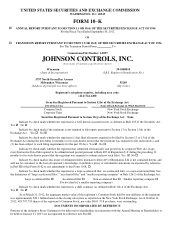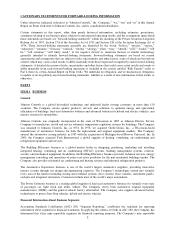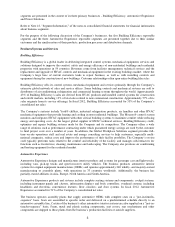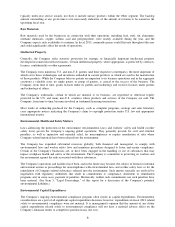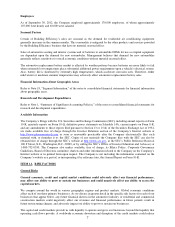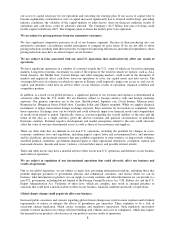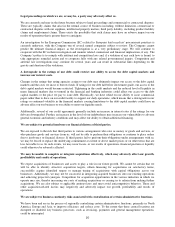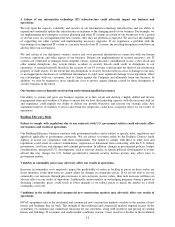Johnson Controls 2012 Annual Report Download - page 8
Download and view the complete annual report
Please find page 8 of the 2012 Johnson Controls annual report below. You can navigate through the pages in the report by either clicking on the pages listed below, or by using the keyword search tool below to find specific information within the annual report.8
our access to capital necessary for our operations and executing our strategic plan. If our access to capital were to
become significantly constrained or costs of capital increased significantly due to lowered credit ratings, prevailing
industry conditions, the volatility of the capital markets or other factors, then our financial condition, results of
operations and cash flows could be adversely affected. The Company’s $2.5 billion four-year revolving credit
facility expires in February 2015. The Company plans to renew the facility prior to its expiration.
We are subject to pricing pressure from our automotive customers.
We face significant competitive pressures in all of our business segments. Because of their purchasing size, our
automotive customers can influence market participants to compete on price terms. If we are not able to offset
pricing reductions resulting from these pressures by improved operating efficiencies and reduced expenditures, those
pricing reductions may have an adverse impact on our business.
We are subject to risks associated with our non-U.S. operations that could adversely affect our results of
operations.
We have significant operations in a number of countries outside the U.S., some of which are located in emerging
markets. Long-term economic uncertainty in some of the regions of the world in which we operate, such as Asia,
South America, the Middle East, Central Europe and other emerging markets, could result in the disruption of
markets and negatively affect cash flows from our operations to cover our capital needs and debt service. The
sovereign debt crisis in countries in which we operate in Europe could negatively impact our access to, and cost of,
capital, and therefore could have an adverse effect on our business, results of operations, financial condition and
competitive position.
In addition, as a result of our global presence, a significant portion of our revenues and expenses is denominated in
currencies other than the U.S. dollar. We are therefore subject to foreign currency risks and foreign exchange
exposure. Our primary exposures are to the euro, British pound, Japanese yen, Czech koruna, Mexican peso,
Romanian lei, Hungarian forint, Polish zloty, Canadian dollar and Chinese renminbi. While we employ financial
instruments to hedge transactional foreign exchange exposure, these activities do not insulate us completely from
those exposures. Exchange rates can be volatile and could adversely impact our financial results and comparability
of results from period to period. Specifically, there is concern regarding the overall stability of the euro and the
future of the euro as a single currency given the diverse economic and political circumstances in individual
Eurozone countries. Potential negative developments and market perceptions related to the euro could adversely
affect the value of our euro-denominated assets, as well as those of our customers and suppliers.
There are other risks that are inherent in our non-U.S. operations, including the potential for changes in socio-
economic conditions, laws and regulations, including import, export, labor and environmental laws, and monetary
and fiscal policies; protectionist measures that may prohibit acquisitions or joint ventures, or impact trade volumes;
unsettled political conditions; government-imposed plant or other operational shutdowns; corruption; natural and
man-made disasters, hazards and losses; violence, civil and labor unrest, and possible terrorist attacks.
These and other factors may have a material adverse effect on our non-U.S. operations and therefore on our business
and results of operations.
We are subject to regulation of our international operations that could adversely affect our business and
results of operations.
Due to our global operations, we are subject to many laws governing international relations, including those that
prohibit improper payments to government officials and commercial customers, and restrict where we can do
business, what information or products we can supply to certain countries and what information we can provide to a
non-U.S. government, including but not limited to the Foreign Corrupt Practices Act, U.K. Bribery Act and the U.S.
Export Administration Act. Violations of these laws, which are complex, may result in criminal penalties or
sanctions that could have a material adverse effect on our business, financial condition and results of operations.
Global climate change could negatively affect our business.
Increased public awareness and concern regarding global climate change may result in more regional and/or federal
requirements to reduce or mitigate the effects of greenhouse gas emissions. There continues to be a lack of
consistent climate legislation, which creates economic and regulatory uncertainty. Such regulatory uncertainty
extends to future incentives for energy efficient buildings and vehicles and costs of compliance, which may impact
the demand for our products, obsolescence of our products and our results of operations.

